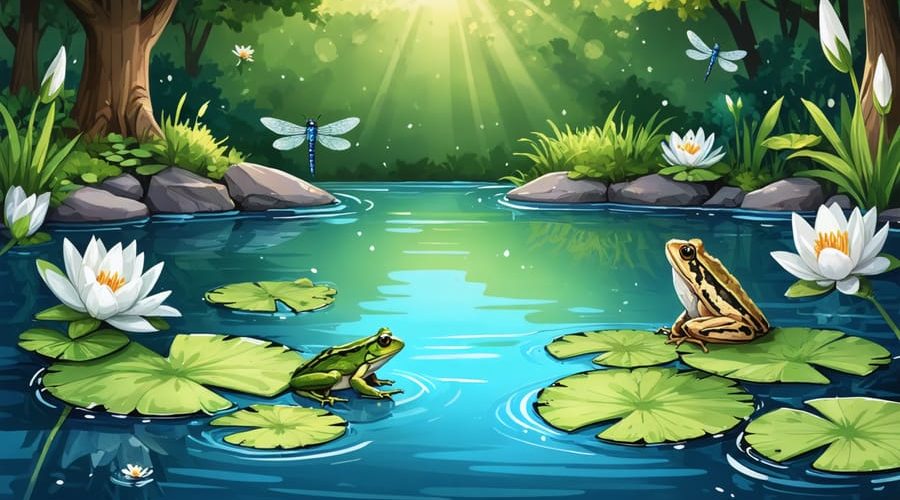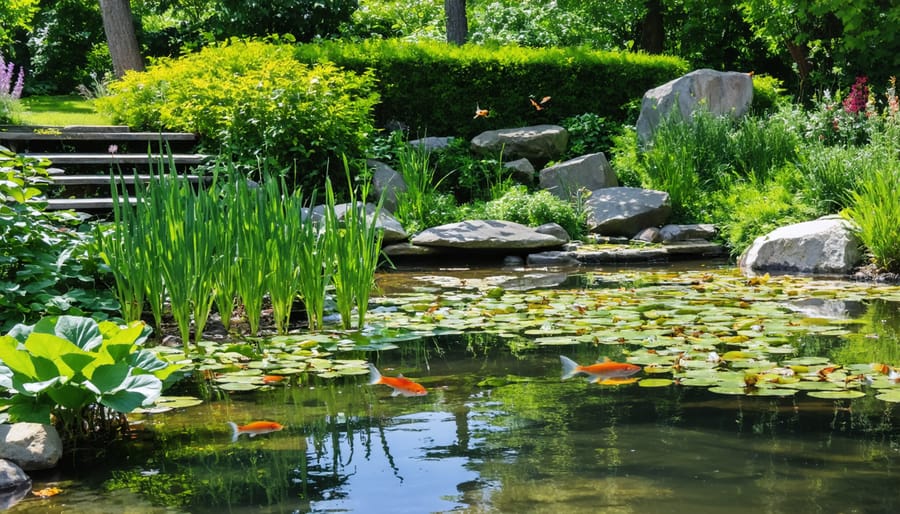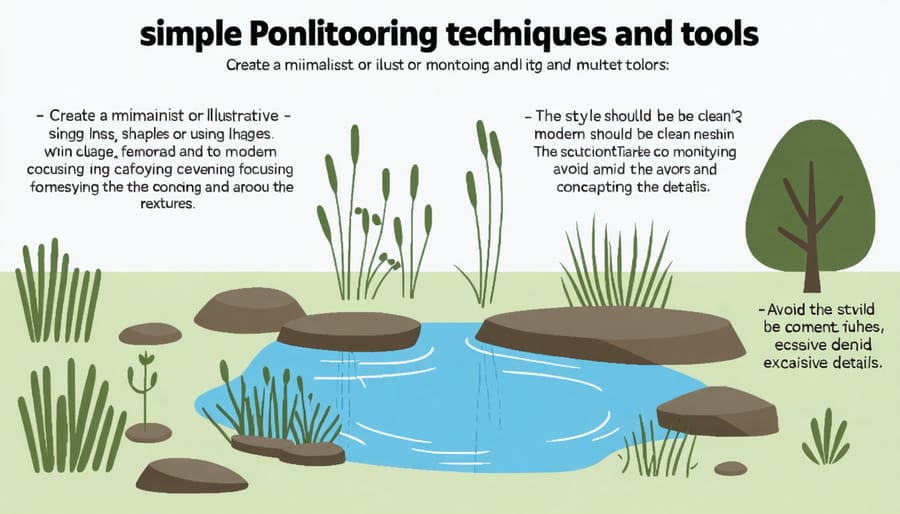
How to Track the Living Treasures in Your Backyard Pond
Monitor the diversity of aquatic life in your pond for a thriving ecosystem. Track key indicator species like dragonflies, amphibians and native plants to gauge pond health. Conduct regular visual surveys, photograph organisms and log observations to detect population changes over time. Test water quality parameters such as pH, dissolved oxygen and nutrient levels which impact biodiversity. Create varied habitats with different depths, substrates and vegetation to support a wide range of species. Small actions to monitor and enhance biodiversity will ensure your pond remains a vibrant oasis of life.
Why Biodiversity Matters in Water Gardens
A thriving water garden is a vibrant tapestry of life, with each organism playing a vital role in maintaining the delicate balance of the pond ecosystem. From the tiniest microbes to the most majestic fish, every creature contributes to the overall health and beauty of your aquatic oasis. By fostering biodiversity in your water garden, you create a self-sustaining environment that is more resilient to external stressors and better equipped to handle natural fluctuations.
A diverse array of pond inhabitants helps to keep the water clean and clear by consuming excess nutrients, breaking down organic matter, and controlling algae growth. Beneficial bacteria, for example, convert harmful ammonia into less toxic compounds, while zooplankton graze on algae and help maintain water clarity. Aquatic plants not only add aesthetic appeal but also provide crucial habitats for fish, amphibians, and insects, while oxygenating the water and absorbing excess nutrients.
Monitoring the biodiversity in your water garden allows you to gauge the overall health of your pond and identify any potential imbalances early on. By regularly observing and documenting the various species present, you can quickly detect changes in population dynamics and take appropriate action to restore equilibrium. A sudden decline in certain species or an overgrowth of others can indicate underlying issues such as poor water quality, nutrient imbalances, or the presence of invasive species.
Embracing biodiversity in your water garden not only enhances its ecological value but also creates a more visually stunning and engaging space for you to enjoy. As you witness the intricate interactions between the various inhabitants of your pond, you’ll gain a deeper appreciation for the wonders of nature and the importance of preserving these delicate ecosystems. By actively monitoring and nurturing the biodiversity in your water garden, you become a steward of your own miniature world, contributing to the conservation of our planet’s precious aquatic resources.
Word count: 299


Key Species to Monitor
Aquatic Plants
Aquatic plants are essential indicators of pond health and biodiversity. From floating beauties like water lilies to submerged oxygenators such as hornwort, each plant plays a crucial role in maintaining a balanced ecosystem. To gauge the well-being of your pond, keep an eye on the variety and vitality of your aquatic plants.
A diverse mix of marginal plants (like irises and rushes), floating plants (such as duckweed and water lettuce), and submerged plants (including pondweed and water milfoil) is a sign of a thriving pond. These plants provide oxygen, filtration, and habitats for various aquatic creatures.
Regularly monitor your aquatic plants for signs of stress, such as yellowing leaves, stunted growth, or excessive algae growth. A sudden decline in plant health could indicate an imbalance in water quality or nutrient levels, prompting you to investigate further and take corrective measures to restore pond equilibrium.
Macroinvertebrates
Macroinvertebrates are tiny creatures like insects, snails, and worms that live in ponds and streams. These little critters serve as excellent indicators of water quality. Certain macroinvertebrate species, such as mayflies, caddisflies, and stoneflies, are quite sensitive to pollution. If you spot them thriving in your pond, it’s a great sign that the water is clean and healthy.
To survey macroinvertebrates, grab a fine mesh net and collect samples from different areas of your pond, including the bottom and along the edges. Gently empty the contents of the net into a shallow white tray filled with some pond water. Use a magnifying glass to identify the various types of macroinvertebrates you find. Keep a record of the species you observe and their quantities. Regularly monitoring these populations will give you valuable insights into the overall health and biodiversity of your pond ecosystem.
Amphibians and Fish
Amphibians and fish bring life and excitement to your backyard pond. Frogs, toads, and newts are fascinating to observe and contribute to the ecosystem by controlling insect populations. Native fish species, such as minnows or shiners, add color and movement while keeping mosquito larvae in check. To monitor their presence, listen for distinctive frog calls in the evening or look for egg masses attached to submerged vegetation in spring. Occasionally, you may spot tadpoles or adult amphibians basking on rocks or plants. For fish, observe the water surface for ripples and splashes, especially during feeding times. Maintaining a balanced and healthy environment will encourage these captivating creatures to thrive in your pond haven.

Simple Monitoring Techniques
Visual Observation
When conducting regular pond checks, take time to observe the variety of life present. Look for different types of aquatic plants, from submerged species like hornwort and waterweed to floating plants such as water lilies and lotus. Note their growth, health, and any changes in coverage. Keep an eye out for beneficial insects like dragonflies, damselflies, and water striders skimming the surface. Peer into the depths to spot various fish, tadpoles, and aquatic invertebrates like snails and freshwater shrimp.
Observe the water clarity and color, as these can indicate the presence of microscopic algae and zooplankton. Use a magnifying glass to get a closer look at tiny creatures living among the plants or swimming in water samples. Take notes on the species you recognize and photograph or sketch unfamiliar organisms for later identification. Regular observation will help you develop a keen eye for the intricate web of life thriving in your backyard pond.
Sampling Methods
When collecting specimens for identification, always prioritize safety for both you and the pond life. Use a fine mesh net to gently scoop up small creatures from different parts of the pond, including the surface, mid-water, and bottom. Transfer specimens to a clear container filled with pond water for observation. Take close-up photos to aid in identification later. If you need to handle any creatures, wear gloves and keep them wet to minimize stress. For insects and other delicate specimens, use soft tweezers or a small paintbrush to avoid damaging them. After documenting your findings, return all specimens back to the pond promptly. Remember, the goal is to observe and learn about the biodiversity in your pond without causing harm to the ecosystem. By treating the sampling process with care and respect, you’ll gain valuable insights into the fascinating world beneath the surface while ensuring the well-being of your pond’s inhabitants.
Tracking Tools
There are many handy tools available to help you monitor the biodiversity in your water garden. Smartphone apps like iNaturalist and Seek allow you to easily identify and record species you encounter. Field guides for aquatic plants, insects, amphibians, and birds are invaluable references to keep on hand. Basic equipment like a hand lens, dip net, white tray, and camera will enable you to get an up-close look at pond life and document your findings. Consider investing in a water testing kit to check parameters like pH, dissolved oxygen, and nutrient levels, which influence biodiversity. With these tools, you’ll be all set to embark on fascinating “bioblitzes” to discover the incredible variety of life in your backyard pond!
Using Your Biodiversity Data
Now that you’ve collected data on the biodiversity in your pond, it’s time to put those insights into action! Understanding the variety of life thriving in your aquatic oasis empowers you to make informed decisions about pond management. For example, if you notice a decline in certain invertebrate populations, it could indicate an imbalance in water chemistry that needs addressing. On the flip side, a surge in algae growth might mean it’s time to introduce more algae-eating fish or adjust nutrient levels.
Your biodiversity observations can also guide landscaping choices around the pond. If you spot a particular bird species frequenting your water feature, consider planting native vegetation that provides food and shelter to encourage their visits. Monitoring the interplay between aquatic and terrestrial life helps you create a harmonious, thriving ecosystem.
Remember, the goal is to strike a balance that supports a diverse array of pond inhabitants. Use your biodiversity data as a roadmap to steer your pond in a healthy, vibrant direction. With regular check-ins and targeted actions, you’ll be amazed at the rich tapestry of life your water garden can sustain. Happy pond-keeping!
Conclusion
Monitoring the biodiversity in your water garden is a rewarding way to connect with nature and ensure the health of your aquatic ecosystem. By regularly observing and documenting the variety of plants, insects, amphibians, and other life in your pond, you can spot changes over time and address any imbalances early on. Whether you’re a beginner or an experienced pond enthusiast, incorporating simple biodiversity surveys into your routine can deepen your appreciation for the rich tapestry of life in your own backyard oasis. So grab a notepad, camera, or field guide, and start exploring the wonders of your water garden’s biodiversity today!
